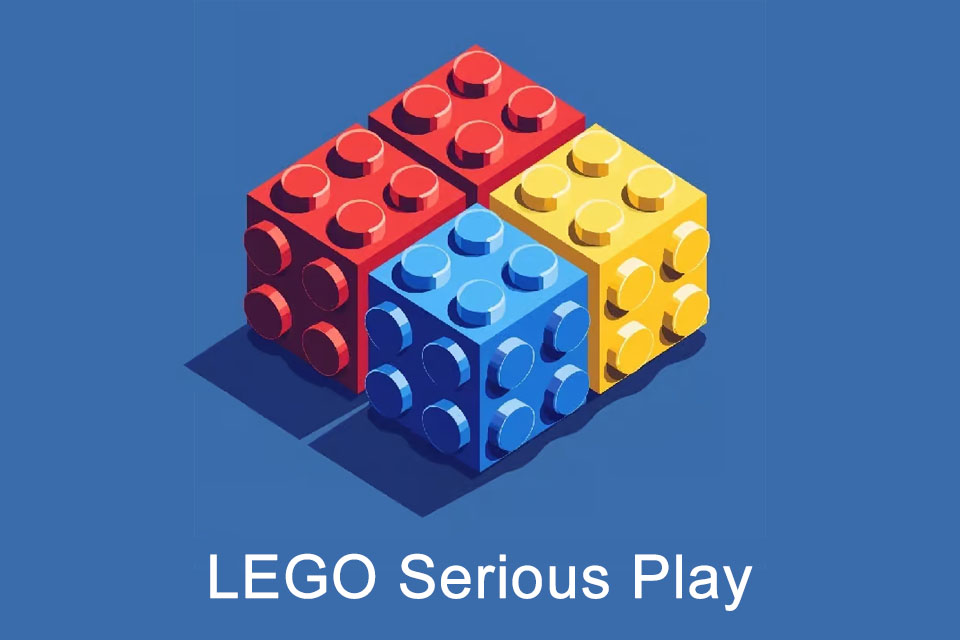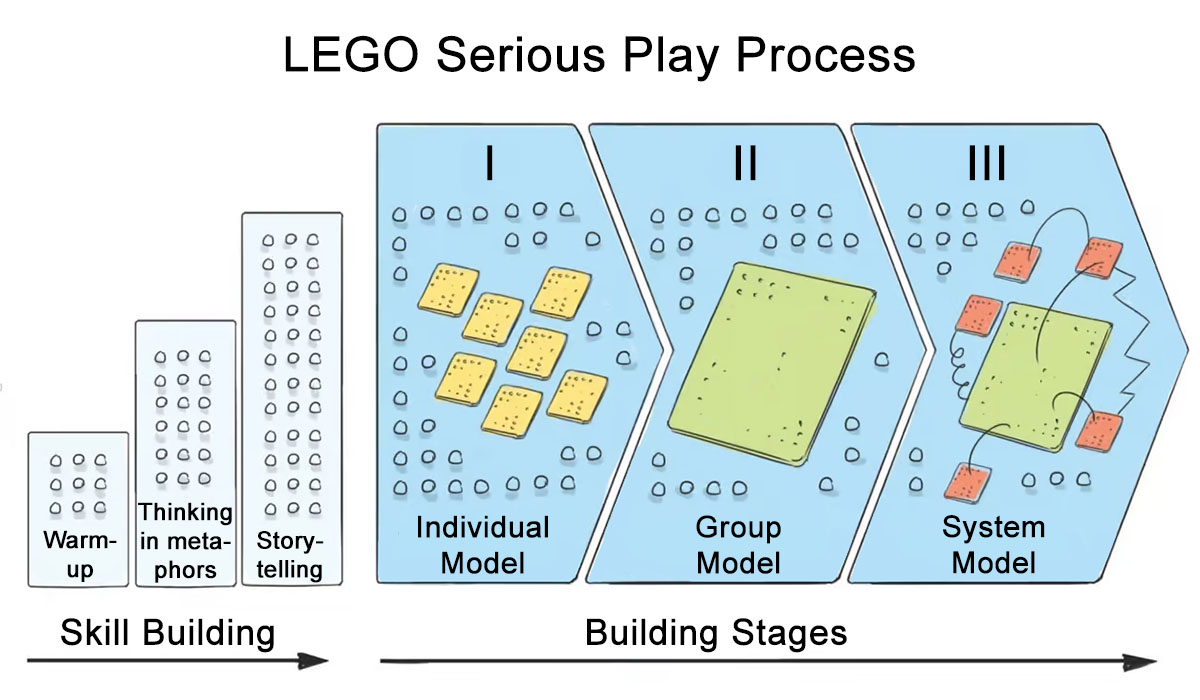What is LEGO Serious Play?
Table of Contents: Definition – Cycle – Process – Scientific foundation – Questions from the field – Notes
LEGO Serious Play – working together as a team through play
LEGO Serious Play is a low-threshold method for working on complex topics in a team. It is based on the idea of using LEGO bricks as a tool for thought processes and problem solving and follows a basic process of building, sharing and reflecting.
In the first step, all participants use LEGO to build their answer to a given question, which is formulated as a ‘building assignment’. Each person then shares their model and thus makes their perspective, thoughts, emotions or ideas understandable to the other team members. A facilitator trained in the method accompanies this process. After sharing, the facilitator opens up a space for reflection and exchange.
This basic process – also known as the LEGO Serious Play cycle – is repeated several times, making concrete next steps visible. In this way, group models or system models can also be created that visualise commonalities, dependencies and new options.
The LEGO Serious Play cycle
The LEGO Serious Play cycle is repeated with every build order. It consists of three steps that are the same for each building phase:
Build: After the presentation of the building task, the participants have time to build. Here they explore and design what they have in mind and what fits the building task. This phase is particularly helpful for people who find it difficult to make themselves understood in order to clarify their attitude to the problem and find the right words.
Share: The construction phase is followed by the sharing phase. The entire attention of the group is focussed on the model of the person sharing. The person guides the group through the model using the LEGO bricks and figures. Each brick can have a meaning determined by the person presenting it. The moderator or group members are allowed to ask questions of understanding, but are not allowed to contribute their own interpretations or touch the model. In this way, a collective understanding of the different perspectives on the problem gradually emerges.
Reflect: Once all models have been presented, reflection follows. The facilitator often introduces this with a specific question to help the group combine the different perspectives into a conclusion.
How does the LEGO Serious Play process work?
LEGO Serious Play – sometimes simply abbreviated to LSP – follows a process consisting of competence building and individual building stages.
Skill building
At the beginning of every LSP workshop is the competence building process. It determines whether the workshop leads to tangible results that are supported by everyone, or whether it fails and leaves behind an insecure team. When organising a workshop, competence building should therefore never be omitted, but should at least always be carried out in short form. Even teams that are familiar with LEGO Serious Play should incorporate skill building into their workshops in order to familiarise themselves with the working method together. Skill building is like warming up for a workout – it ensures that participants can deliver the best possible results.
Skill building consists of three steps that prepare you to present your inner world confidently and purposefully.
1. warm-up
For many, the warm-up is their first contact with LEGO in a long time or even their first contact at all. Here the participants learn (again) how to put the bricks together and what other parts and connections there are. The rustling of the boxes announces that something else is now on the programme.
2. thinking in metaphors
Once the craftsmanship skills have been (re)activated, they have to give meaning to the bricks. How can project management be visualised in ten bricks? That depends entirely on the ideas of the builders! This requires creativity, which needs to be awakened. In this phase, everyone learns a fundamental principle of LSP: only the person who built the model determines what it represents.
3. storytelling
LEGO Serious Play models created during a workshop are fully GDPR-compliant. Without the builder’s explanation, it remains unclear what the model represents. Precise sharing is therefore crucial. But this needs to be learnt. This is why the building assignment for this phase often refers to a personal experience that is very clear in the participants’ minds – a formative situation or an unusual story. This gives the models a timeline and makes sharing easier for everyone. The team often grows closer together in the process.
Building stages 1 – 3
Once the skill building is complete, the participants can tackle the central questions of the workshop. The so-called building stages begin:
- Building stage 1 – The individual model
It is important to understand a problem in order to be able to work on it. All participants therefore develop their own answer to the construction brief. The wording of the construction brief is crucial here. It should be understandable and clear in order to avoid confusion in the sharing phase. The sharing and the subsequent reflection take place directly after the end of the construction period and are moderated by the facilitator.
- Building stage 2 – The group model
In the second construction phase, the participants assemble their personal thoughts in 3D. A large LEGO board serves as a base on which they place important aspects of their models. What seems important is placed on the plate, irrelevant aspects are removed. During the joint building process, discussions are held to help the team realise which solution is necessary. A vote then highlights the most important aspects. At the end of this phase, each person has contributed something and recognises these elements in the overall model.
- Building stage 3 – The system model
Once the group has understood the model, it is time to recognise external factors and create connections. First, the participants build individual models of the factors that influence the group model. In the next step, they link the group model with these factors and also link the factors with each other. In doing so, they often discover connections that the team had previously missed.
LEGO Serious Play process [1]
Once the building phases have been completed, the models are documented so that the team can continue to work with the results they have found in the best possible way.
Depending on the workshop, other building assignments and phases may be suitable, but the classic process has proven itself in many settings. Of course, the method can also be used in combination with other workshop formats; for professional workshop leaders, for example, there are training opportunities to become an LSP Advanced Facilitator. [2]
The scientific foundation of LEGO Serious Play
Why is LEGO Serious Play effective? Because the method is based on a solid scientific foundation and utilises various contexts:
The process of the method creates psychological safety. [3] Psychological safety means that participants can express their opinions, questions and mistakes freely and without fear of negative consequences, which promotes open communication and collaboration. [4] The concept is seen as a prerequisite for high-performance teams and motivated Google, among others, to conduct its large-scale Aristotle research project. [5]
As nothing ‘wrong’ can be built in an LSP workshop and all participants have their say, teams learn what a psychologically safe environment feels like. On the one hand, this produces tangible results and, on the other, principles are learnt, particularly through repeated use, that enable long-term successful collaboration through transparent communication.
In this method, construction takes centre stage. On the one hand, this leads to unfavourable solutions being visualised and thus easily recognised. On the other hand, the construction process forces you to think about alternatives immediately. This promotes a solution-orientated approach and prevents problems from simply being described in detail.
In addition, there are at least four reasons why LEGO Serious Play works:
1. the hand-brain principle
Many participants initially find it difficult to visualise complex concepts with just a few LEGO bricks or figures, but almost everyone comes up with ideas as soon as they put the first bricks together. By using the hands to work on problems – also known as embodied cognition – areas of the brain that are not normally activated are used to find solutions. This creates additional perspectives from which to view the problem and often results in more creative, courageous and sustainable proposals.
2. radical simplification
The use of metaphors for the stones forces participants to model the aspects of a thought process that are most relevant to them. As a result, they do not get lost in the details during the solution finding process, as is often the case in traditional meetings. Visualising an idea using LEGO ensures that participants stick to content that brings them closer to the goal instead of thinking it through in too much detail too soon.
3. LEGO as a medium
When people place their inner world on the table as a visible model, they can talk about the model instead of themselves. This separation makes it easier to address critical issues at an early stage. The earlier these become transparent, the easier it is to initiate countermeasures.
What’s more, everything can theoretically be modelled with LEGO. Just six simple bricks with 2×6 studs can be used to build 915,103,765 different models. If other LEGO parts and connectors are added, the possibilities are endless. It is not so easy to create the same model within a group – and therefore many different ideas.
4. overcoming groupthink
Groupthink refers to a phenomenon in which people follow the assumed or actual majority opinion of a group in order to maintain a group consensus. Groupthink can be overcome with the help of LSP, as the participants first think about the problem or question – aka construction contract – for themselves and propose solutions before they have the opportunity to simply join the general opinion. This creates a space to look at a topic from different perspectives and the opportunity to seriously scrutinise things.
In addition, various research studies show that LEGO Serious Play
- supports diverse groups to come together as equals. [6]
- stimulates creativity and thus makes subsequent creative processes such as design thinking more effective. [7]
- creates additional flow experiences for workshop participants. [8]
- better consolidates knowledge content that is developed using the method. [9]
- promotes the coachees’ ability to reflect during coaching. [10]
- increases motivation when working on tasks. [11] [12]
In addition, it can be observed time and again in practice that teams perceive themselves as more self-effective as a result of the method. Many participants are surprised by their own creativity and realise that there are far more solutions than they had previously expected.
Questions from the field
Here you will find some questions and answers from practice:
Who developed LEGO Serious Play?
The method was developed over many years of research, particularly at the International Institute for Management Development (IMD) in Lausanne. In the 1990s, the two professors Johan Roos and Bart Victor were researching a more creative, effective and responsible method of strategy development that would help managers to incorporate subjective perspectives into long-term planning processes.
At the time, the LEGO Group was in a precarious situation due to the emergence of the video game industry. Previous collaborations between IMD and LEGO, as well as the growing interest of LEGO CEO Kjeld Kirk Kristiansen in the method, led to further joint development.
When the company released the method as open source in 2010, interest in it grew strongly and it spread internationally. [13] However, the LEGO Group continues to offer customised sets. Today, LSP is used by many large companies such as Google, SAP, eBay and NASA.
For which areas of application is LEGO Serious Play suitable?
Like any method, LSP has its strengths and weaknesses. When used skilfully, however, it can initiate strong changes in perspective, give a team a clear direction or show new, innovative paths that would otherwise not have been seriously considered.
The method is particularly suitable for the following areas:
- Strategy development and implementation
- Vision, mission and mission statement development
- Identification of team or organisational values / identity
- Innovation (e.g. in combination with design thinking)
- Team development
- Stress prevention training
- Retrospectives
- prototyping
- Conflict management and mediation
Of course, LSP can also be used in (individual) coaching.
With how many people can a workshop be organised and how long is the recommended duration?
Depending on the topic and objective, an LSP workshop lasts between 3 hours and several days. However, shorter formats of 20 minutes or more are also possible as an ‘icebreaker’ or short input.
The longer the workshop, the more intensively topics can be explored and the strengths of the method are more clearly emphasised. The LEGO material fades more and more into the background and becomes a tool for co-creative, diverse and honest communication thanks to the increasing expertise of the users. And thus paving the way for a transparent further development of the content aspects.
What are the advantages and disadvantages of LEGO Serious Play?
- By using LEGO bricks, participants are encouraged to express their thoughts in new and creative ways. This can lead to innovative solutions that may not be achieved through traditional methods.
- As each participant builds a model and explains it to the group, everyone has their say. This encourages open communication, which is often lacking in traditional meetings.
- Abstract concepts and problems become tangible through the construction of models. This helps participants to better understand and discuss complex topics.
- The method is very participative and ensures that everyone actively takes part in the process. This can lead to greater team cohesion and better results.
- As all participants contribute their ideas equally by building models, the power imbalance between hierarchical positions is (temporarily) reduced during the session or workshop.
- Building and sharing the models encourages participants to reflect on their assumptions and emotions, which can lead to deeper understanding and better insights.
- The combination of physical activity (building) and verbal explanation (sharing) helps to anchor information better. Participants often remember the discussions and outcomes of an LSP workshop longer and in more detail than traditional meetings.
In addition to the advantages, there are also some disadvantages:
- The method can be time-consuming. Especially with complex topics, it can take a long time to achieve the desired results.
- Running an LSP workshop can be expensive, especially if mistakes are made in the preparation or inexperienced facilitators are used. The sets of stones and figures are not cheap either.
- In some companies or with some participants, the method can meet with resistance. Some may perceive the toys as unprofessional or not take the method seriously.
- In certain cultures, playing with LEGO bricks could be seen as childish or unprofessional. This can lead to misunderstandings and affect the usefulness of the method, as cultural barriers can reduce the willingness to participate.
- The method can be problematic in groups with pre-existing tensions or conflicts. Whilst LSP aims to resolve these, unresolved conflicts can be exacerbated by the process, especially if participants are stressed by the creative pressure they feel.
- In very large groups, it can be difficult to maintain the focus and concentration of participants. The process can become fragmented and ineffective if there is not enough time or facilitation available.
- A potential disadvantage is that the creative and innovative ideas developed in a LSP workshop may not be adequately integrated into regular work processes later on. Without clear follow-up and implementation, the results often fall by the wayside.
Conclusion: LEGO Serious Play offers many advantages, especially when it comes to promoting creative thinking and open communication. It is a powerful method when it comes to strengthening teams and solving complex problems. However, it is not suitable for every situation and requires careful planning and implementation.
What tips are useful for using LEGO Serious Play?
- The building assignments are the central elements of an LSP workshop. For good results you need good building assignments.
- It makes sense to familiarise yourself with the various LSP sets. The better you can estimate in advance when which sets will be used, the easier it will be to conduct the workshop. [14]
- Pay attention to how you market your workshops with LSP. It is important to LEGO that organisations or people who work with LEGO Serious Play are not perceived as representatives of the LEGO Group. So make it clear in your workshops that you are only using the LEGO method, but are not working for the Group. You can find more detailed information in the official guidelines. [15]
- Invest sufficient time in planning and understanding the entire process, especially for the first workshop. Above all, it is important that the facilitators are experienced in the method and can create a framework in which everyone feels psychologically safe.
When used correctly, the method produces valuable results and ensures more efficient collaboration through transparent communication and psychological safety. The more self-organised teams are, the more relevant it is to exchange different perspectives, thoughts and emotions in order to find the best possible solution to a complex problem. This is where LSP really shines.
Impulse to discuss:
When is LSP more suitable than other methods?
Notes (some in German):
LEGO, the LEGO logo and SERIOUS PLAY are registered trademarks of the LEGO Group.
[1] Hillmer, D. (2021) PLAY! Der unverzichtbare LEGO® SERIOUS PLAY® Praxis-Guide für Trainer, Coaches und Moderatoren.
[2] Ausbildung zum LSP Advanced Facilitator
[3] Quinn, T., Trinh, S. ho, & Passmore, J. (2021). An exploration into using LEGO® SERIOUS PLAY® (LSP) within a positive psychology framework in individual coaching: an interpretative phenomenological analysis (IPA). Coaching: An International Journal of Theory, Research and Practice, 15(1), 102–116.
[4] Edmondson, A. (1999). Psychological safety and learning behavior in work teams. Administrative Science Quarterly, 44, 350–383.
[5] CNBCs: What Google Learned From Its Quest to Build the Perfect Team
[6] McCusker, S. (2014). LEGO® Serious Play TM: Thinking about teaching and learning. International journal of knowledge, innovation and entrepreneurship, 2(1), 27-37.
[7] Primus, D. J., & Sonnenburg, S. (2018). Flow Experience in Design Thinking and Practical Synergies with Lego Serious Play. Creativity Research Journal, 30(1), 104–112, https://www.researchgate.net/publication/322810414_Flow_Experience_in_Design_Thinking_and_Practical_Synergies_with_Lego_Serious_Play
[8] Zenk, L., Primus, D.J. and Sonnenburg, S. (2022), Alone but together: flow experience and its impact on creative output in LEGO® SERIOUS PLAY®, European Journal of Innovation Management, Vol. 25 No. 6, pp. 340-364. https://www.emerald.com/insight/content/doi/10.1108/ejim-09-2020-0362/full/pdf
[9] Benesova, N. (2023). LEGO® Serious Play® in management education. Cogent Education, 10(2), https://www.tandfonline.com/doi/full/10.1080/2331186X.2023.2262284
[10] Moore, M. & O’Sullivan, D. (2023). One-to-one LEGO® SERIOUS PLAY® positive psychology coaching for emerging adults: a single-participant case study. International Journal Of Mentoring And Coaching in Education, 12(3), 233–250.
[11] Howland, A. A., Baird, K. A., Pocock, A., Coy, S., & Arbuckle, C. (2013). Supporting language acquisition and content-specific science access: universal design for learning using LEGO we dos to teach simple machines. In Hawaii University International Conferences Education & Technology.
[12] Lopez-Fernandez, D., Gordillo, A., Ortega, F., Yague, A. & Tovar, E. (2021). LEGO® Serious play in Software Engineering education. IEEE Access, 9, 103120–103131, https://www.researchgate.net/publication/353113372_LEGOR_Serious_Play_in_Software_Engineering_Education
[13] Roos, J. & Victor, B. (2018). How it all began: The origins of LEGO® Serious Play®. International Journal Of Management And Applied Research, 326–343.
[14] Video: Das Material für LSP – Übersicht über die Sets und Einsatzszenarien
[15] PDF: LSP Guidelines
Here you can find an interesting podcast episode on LSP in German.
Looking for a service provider? Our recommendation: David Hillmer und HelloAgile – Akademie & Beratung
And here you can find additional information from our t2informatik Blog:





